These worksheets will begin by explore the fundamental structure of a volcano and get familiar with what they are. We will then look at how volcanoes form and where they are located geographically. Students will explore why volcanoes erupt and how to predict this or have a good understanding of when it may occur. We will look at lava flows and how to classify them. We will then look at what we as humans have discovered about volcanoes on own planet and others. The worksheets include the basic anatomy, formation, classification, and locations of these natural wonders. We also look at the concept of Tsunamis.
Print Volcano Worksheets
Click the buttons to print each worksheet and associated answer key.

Volcano Anatomy
The diagram below shows an erupting volcano, provide the names of the features indicated using the following terms.

The Ring of Fire
The world has more than 500 active volcanoes. Over half of these surround the Pacific Ocean along a line called the "Ring of Fire".

Naming Cones
Volcanoes can be classified according to the shapes of their cones. Name each of the cones below with the correct name: cinder, composite, or shield.

Igneous Rock
When molten rock (i.e., magma) hardens it forms igneous rock, one of the three major types of rock. Magma does not always make it to the surface as lava in a volcano however, sometimes it forms other igneous rock structures underground.
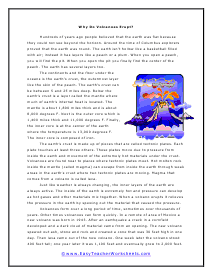
Why Do Volcanoes Erupt?
Hundreds of years ago people believed that the earth was flat because they could not see beyond the horizon. Around the time of Columbus explorers proved that the earth was round.
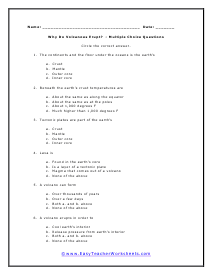
Eruption Multiple Choice Questions
Volcanoes form over a long period of time, sometimes over thousands of years. Other times they can form quickly.
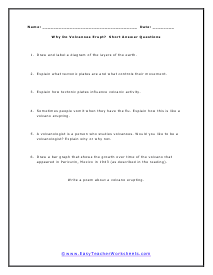

Volcano Disasters
A disastrous volcanic eruption occurred in 1883 on the island of Krakatau, also in Indonesia. Krakatau began erupting on August 26 and put out an ash cloud 17 miles high.
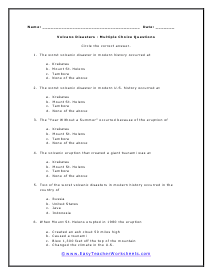
Disasters Multiple Choice Questions
Two of the worst volcanic disasters in modern history occurred in the country of ___________________.
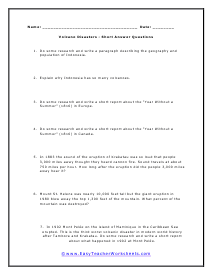
Disasters Short Answer Questions
In 1883 the sound of the eruption of Krakatau was so loud that people 3,000 miles away thought they heard cannon fire. Sound travels at about 750 miles per hour.
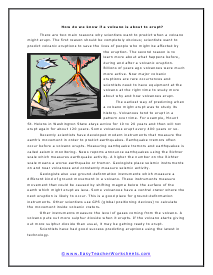
Is It Going To Erupt?
There are two main reasons why scientists want to predict when a volcano might erupt. The first reason should be completely obvious; scientists want to predict volcanic eruptions to save the lives of people who might be affected by the eruption.

Going To Erupt Multiple Choice Questions
The earliest way of predicting when a volcano might erupt was to study its history. Volcanoes tend to erupt in a pattern over time. For example, Mount St. Helens in Washington State stays active for 10 to 20 years and then will not erupt again for about 120 years.

Going To Erupt Short Answer Questions
Geologists and volcanologists work in volcanoes when they place instruments and take samples of lava. This is dangerous work and some researchers have died while studying these unpredictable locations.
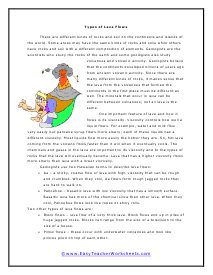
Types of Lava Flows
There are different kinds of rocks and soil on the continents and islands of the world. Some areas may have the same kinds of rocks and soils while others have rocks and soil with a different composition of elements.
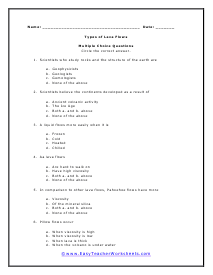
Types of Lava Flow Multiple Choice
In comparison to other lava flows, Pahoehoe flows have more what?
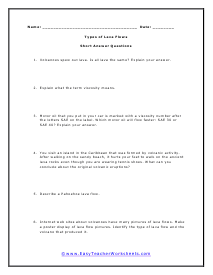
Types of Lava Flows Short Answers
Motor oil that you put in your car is marked with a viscosity number after the letters SAE on the label. Which motor oil will flow faster: SAE 30 or SAE 40?
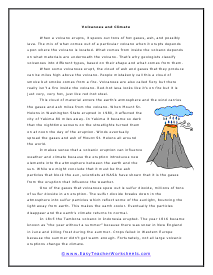
Volcanoes and Climate
When a volcano erupts, it spews out tons of hot gases, ash, and possibly lava. The mix of what comes out of a particular volcano when it erupts depends upon where the volcano is located.
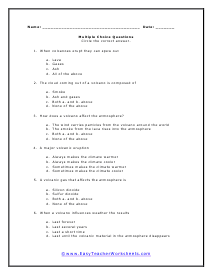
Climate Multiple Choice Questions
When some volcanoes erupt, the cloud of ash and gases that they produce can be miles high above the volcano.
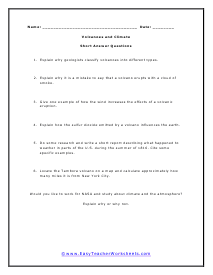
Climate Short Answer Questions
Locate the Tambora volcano on a map and calculate approximately how many miles it is from New York City.
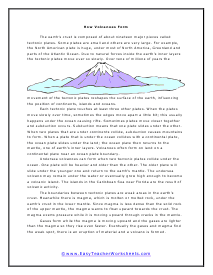
How They Form
The earth's crust is composed of about nineteen major pieces called tectonic plates. Some plates are small and others are very large.
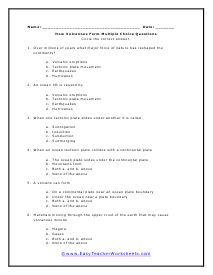
Forming Multiple Choice Questions
Over millions of years what major force of nature has reshaped the continents?
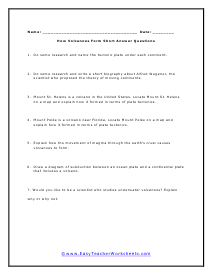
Forming Question Set
Mount St. Helens is a volcano in the United States. Locate Mount St. Helens on a map and explain how it formed in terms of plate tectonics.
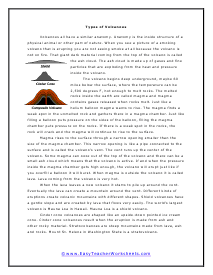
Types of Volcanoes
Volcanoes all have a similar anatomy. Anatomy is the inside structure of a physical animal or other part of nature. When you see a picture of a smoking volcano that is erupting you are not seeing smoke at all because the volcano is not on fire.
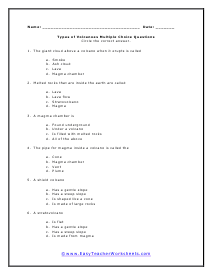
Types Multiple Choice Questions
Magma rises to the surface through a narrow opening smaller than the size of the magma chamber. This narrow opening is like a pipe connected to the surface and is called the volcano’s vent.
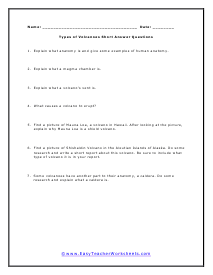
Types Short Answer Questions
The volcano begins deep underground, maybe 60 miles below the surface, where the temperature can be 2,500 degrees F, hot enough to melt rocks.

The Pacific Ring of Fire
What an exciting and descriptive name for a geological phenomenon, the Pacific Ring of Fire. The Ring of Fire refers to the large number of volcanoes that are found surrounding the Pacific Ocean.
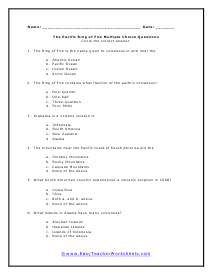
Ring of Fire Multiple Choice Questions
Those found near Australia and New Zealand are younger than those found in Indonesia. There are volcanoes on some of the islands of New Zealand as well as in the Pacific Ocean off the coast of Australia.
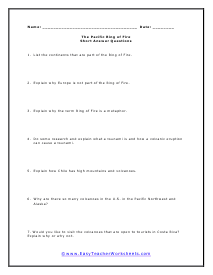
The Pacific Ring of Fire Short Answer Questions
The United States and Canada in North America also have volcanoes that are part of the Pacific Ring of Fire. Mount St. Helens in Washington State erupted in 1980 and the area around the mountain still has no vegetation 30 years later.

Volcanoes Help the Earth
Giant plumes of ash and gases from volcanoes pollute the air after an eruption and the particles in the air can reflect sunlight away from the earth, causing temperatures to cool for awhile.
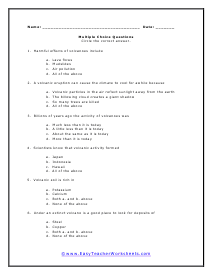
Helping Earth Multiple Choice Questions
Volcanoes may be responsible for the oceans and continents and even life itself. Billions of years ago, they were much more active than they are today.
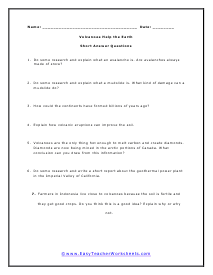
Helping Earth Short Answer Questions
Over time, lava flows from a volcano break down and eventually form fertile soil. Volcanic soil is rich in calcium and potassium that growing plants need.
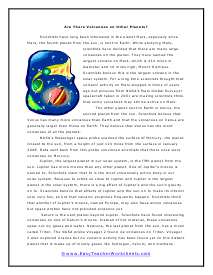
Are There Volcanoes on Other Planets?
Scientists have long been interested in the planet Mars, especially since Mars, the fourth planet from the sun, is next to Earth. While studying Mars, scientists have decided that there are many large volcanoes on the planet.

Other Planets Multiple Choice Questions
The other planet next to Earth is Venus, the second planet from the sun. Scientists believe that Venus has many more volcanoes than Earth and that they are generally larger than those on Earth.
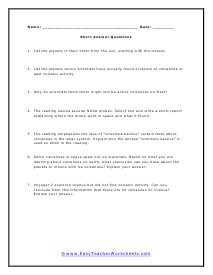
Other Planets Short Answer Questions
Jupiter, the largest planet in our solar system, is the fifth planet from the sun. Jupiter has more moons than any other planet.
Types of Volcanoes
Volcanoes are usually mountainous, but do not always take this form. They are landforms where hot molten rock and erupt through cracks in the surface of the Earth. They can even be found under water in oceans. The Pacific Ocean area is literally packed with them. There are thought to be just over one-thousand five-hundred active volcanoes in the world. When they erupt, they release hazardous gases, rock, ash, and molten rock (lava). An eruption can also create mudslides and avalanches depending on the surrounding terrain. When an eruption occurs, it creates a clear and present danger for a twenty-mile radius for it. Eruptions difference in the level of activity. Some eruptions are subtle, and others are explosively violent. The dangers in eruptions are often misunderstood. Many people fear succumbing to melting lava flows, but this actually ranks very low on the actual volcanic hazards list because lava advances at about six mile per hour, which is not especially fast. The real danger in a volcanic eruption is expulsion of hot gases and ash as they can choke out all life that they encounter.
They are both magnificent and terrifying: magnificent for their gorgeous, natural structures and terrifying for virtually unpredictable eruptions. Each volcano belongs to a specific type, and understanding the different types will allow you to appreciate them more.
Here are a few of the different types of volcanoes:
- Cinder cones
- Composite
- Shield
- Volcanic domes
- Calderas
- Supervolcanoes
- Monogenetic
- Polygenetic
Specific characteristics, like structure or frequency of eruptions, make each volcano type unique, as you'll discover by reading this article.
1. Cinder Cones
Cinder cones are also known as spatter cones or scoria cones. As the most common and simplest volcano type, they are recognizable for their steep cones with prominent craters.
If you visit a cinder cone, expect to see scoria and lava flow around its base. Scorias are hardened lava fragments that typically surround cinder cones and are irregularly shaped.
These are examples of cinder cones:
- Capulin Volcano
- Crater Lake National Park
- Cinder Cone National Natural Landmark
2. Composite
Composite volcanoes may be more known by their other term: stratovolcanoes. They usually appear as large concave-shaped cones with steep, snow-covered tops.
Viscous lava led to the formation of steep cones in composite forms. Such steep cones make for marvelous structures, as evident in stratovolcanoes Mount Mayon and Mount Fuji, both considered among the world's most breathtaking sceneries.
Stratovolcanoes are typically active. They may also be composed of various entities like lava flows, deposits, and domes.
Some examples of composite forms are:
- Mayon Volcano
- Mount Rainier
- Mount St. Helens
- Mount Fuji
3. Shield
The title of largest volcanoes belongs to the shield form. Unlike the steep cinder cones and stratovolcanoes, shield types are known for being gentle-sloped, convex-shaped, and broad.
The slopes of shield forms are the result of thin and runny lava. Such lava can travel farther, resulting in a broad slope.
Famous examples of these guys are:
- Mauna Loa
- Mauna Kea
- Mount Wrangell
4. Volcanic Domes
Volcanic domes are formed by viscous lava. These structures are usually small, steep, rough, and craterless. They can also form on the surfaces of other volcanoes, such as stratovolcanoes. They do so by piling on top of vents or openings until a dome-shaped structure is formed.
5. Calderas
Calderas are formed when volcanoes collapse after an eruption. They are so large that lakes, such as those of the Taal Volcano and the Crater Lake caldera, can exist within them.
There are various caldera types:
- Explosive. Explosive calderas are formed on silicic volcano systems. The eruption that created them was explosive, with eruptive columns and large-volume ash flows.
- Nonexplosive. Nonexplosive calderas are formed on shield volcanoes. They are the result of extensive lava flows.
- Resurgent. This is the largest caldera type and can be created by supervolcano explosions.
6. Supervolcanoes
If a volcano had an eruption categorized as Level 8 based on the Volcanic Explosivity Index, they are considered supervolcanoes.
Supervolcanoes are very dangerous and destructive. Lava flows are extensive, and eruption clouds are gigantic. Ashes can travel across countries or oceans. Explosions can result in resurgent calderas.
Some famous supervolcanoes include:
- Yellowstone (USA)
- Aira Caldera (Japan)
- Taupo (New Zealand)
- Toba (Indonesia)
- Long Valley (USA)
- Mount Pinatubo (Philippines)
7. Monogenetic
Did you know that some volcanoes erupt only once in their lifetime? These are called monogenetic. Several of these monogenetics may be found together as a cluster. Clusters usually occur over areas of low magma supply.
Cinder cones and domes tend to be monogenetic. Other less-known monogenetic volcano types are maar and tuff rings, which are low volcanoes with vast craters.
8. Polygenetic
While monogenetic volcanoes can only erupt once, polygenetic forms are the exact opposite. They can - and do - erupt multiple times. They are often bigger than monogenetic volcanoes. Typically, polygenetics include composites, shield, and calderas.


